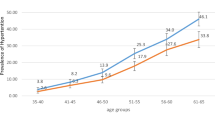Abstract
The aim of the project is to assess the quality and improve the preventive and curative practices at the primary care level in Hungary. A total of 50 general practitionaires were selected on a voluntary basis in Budapest, Hungary, and from them, 30 were randomized to the intervention (I) group and 20 to the reference (R) group. The members in the I group have been trained for the official hypertension guideline and their everyday work is monitored. Those in the R group have only been monitored to measure the efficacy of the training. In all, 10% from the known hypertensive persons (N=10,799) and 5% of the remaining (nonhypertensive) patients (N=60,341) were selected randomly from the GP's computer files and invited for screening investigation performed by trained medical students. They measured the blood pressure of patients, assessed the cardiovascular risk status and the quality of education of patients by standardized questionnaires. In total, 4083 patients were invited, but only 39.2% attended the screening visit. The prevalence of undetected hypertension was 34.6%. This prevalence was significantly higher in the older (>60 years: 46.8%) than in the younger (<50 years: 20.8%, P<0.0001) age group and it was higher in men (41.5%) than in women (30.1%, P<0.001). The proportion of H patients on drug treatment was 85.3% and the frequency of patients under effective blood pressure control (eg<140/90 mmHg) was 27.8%. Counselling to patients for a healthier lifestyle (exercise, smoking, alcohol consumption, diet) was very rare. In conclusion, our data represent the primary care of Budapest and may not be relevant to the whole country. As a consequence of this study, education of primary care physicians and patients is a must for further improvement of hypertension care.
This is a preview of subscription content, access via your institution
Access options
Subscribe to this journal
Receive 12 digital issues and online access to articles
$119.00 per year
only $9.92 per issue
Buy this article
- Purchase on Springer Link
- Instant access to full article PDF
Prices may be subject to local taxes which are calculated during checkout
Similar content being viewed by others
References
Burt VL et al. Prevalence of hypertension in the US adult population: results from the third National Health and Nutrition Examination Survey, 1988–1991. Hypertension 1995; 25: 305–313.
Kishegyi J, Duba J on behalf of the team. Patient education project: a joint WHO-WHL undertaking—experience from Hungary. J Hum Hypertens 1995; 9: 47–50.
Vargáné Hajdú P, Ádány R . Trends of premature mortality from cardiovascular diseases in Hungary and the European Union, 1970–1997. Orvosi Hetilap 2000; 141: 601–607 (in Hungarian).
Joint National Committee on Detection, Evaluation, and Treatment of High Blood Pressure. The Fifth Report of the Joint National Committee on Detection, Evaluation, and Treatment of High Blood Pressure (JNC V). Arch Intern Med 1993; 153(2): 154–183.
Shea S, Gemson OH, Mossel P . Management of high blood cholesterol, diffusion of the National Cholesterol Education Program. J Gen Intern Med 1990; 5: 327–334.
Swales JD . Current clinical practice in hypertension: the EISBERG (Evaluation and Interventions for Systolic Blood pressure Elevation-Regional and Global) project. Am Heart J 1999; 138(3 Part 2): 231–237.
Gerstein HC et al. A controlled evaluation of a national continuing medical education program designed to improve family physicians' implementation of diabetes-specific clinical practice guidelines. Diabet Med 1999; 6(11): 964–969.
Szirmai LA, Arnold C, Farsang C . Improving control of hypertension by an integrated approach—results of the ‘Manage It Well (MIW)’ program. Hypertonia Nephrol 2001; 6: 41–49 (in Hungarian with English abstract).
Kishegyi J, Tornóci L, Lamm Gy . Cardiovascular health state of Hungary, 1995. Népegészségügy 1977; 78: 22–25 (in Hungarian).
Hiddink GJ et al. Nutrition guidance by primary-care physicians: perceived barriers and low involvement. Eur J Clin Nutr 1995; 49(11): 842–851.
Author information
Authors and Affiliations
Consortia
Corresponding author
Rights and permissions
About this article
Cite this article
Farsang, C., Alföldi, S., Barna, I. et al. Effective control of hypertension: a project of the Hungarian society of hypertension, baseline data. J Hum Hypertens 18, 591–594 (2004). https://doi.org/10.1038/sj.jhh.1001695
Published:
Issue Date:
DOI: https://doi.org/10.1038/sj.jhh.1001695
Keywords
This article is cited by
-
High Prevalence of Prehypertension and Hypertension in a Working Population in Hungary
American Journal of Hypertension (2012)
-
Detection and treatment of hypertension in general health-care practice: a patient-based study
Journal of Human Hypertension (2005)



